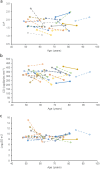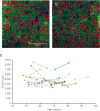A 10-Year Longitudinal Study of Muscle Morphology and Performance in Masters Sprinters
- PMID: 40289323
- PMCID: PMC12034575
- DOI: 10.1002/jcsm.13822
A 10-Year Longitudinal Study of Muscle Morphology and Performance in Masters Sprinters
Abstract
Background: Both longitudinal and cross-sectional studies have demonstrated that muscle mass, strength and power are lost with ageing. Although longitudinal studies have shown changes in muscle morphology and function in sedentary, healthy active and endurance-trained older people, less is known about such age-related changes in sprint athletes. It has been proposed that active older people may provide a better study of healthy ageing not confounded by factors of inactivity and other unhealthy behaviours. Given that the training regimens of masters sprinters consist of strength and sprint training that elicit gains in muscle force, power and mass, sprinters may not suffer from measurable decrements in muscle strength, functional performance or morphology over a 10-year period.
Methods: To investigate this, m. vastus lateralis (VL) biopsies were taken from 24 masters sprinters aged 48-85 years at baseline and 10 years later. Immunofluorescent staining of slides taken from these biopsies was used to assess fibre type composition, fibre cross-sectional area (FCSA) and capillarisation. In addition, VL thickness was assessed using B-mode ultrasonography, maximum voluntary contraction (MVC) of knee extension was measured with an electromechanical dynamometer, and the flight time of a counter movement jump was determined with a contact matt. 60-m sprint times were measured using double-beam photocell gates connected to an electronic timer.
Results: FCSA, fibre-type composition, capillarisation and VL thickness had not changed significantly after 10 years. The decrease in jump power (-9.5% ± 5.7, p < 0.001) was attributable to a concomitant decrease in knee extension MVC (-21.0% ± 20.4, p < 0.001), not slowing of the muscle. Athletes demonstrated reduced 60-m sprint performance after 10 years (+14.2% increase in sprint time ± 12.4, p < 0.001) with greater loss in performance found in older participants (stepwise regression p < 0.004). Similarly, the loss of jump power found in the follow-up measurement (-9.47% ± 5.7, p < 0.001) was larger in the older participants (stepwise regression p < 0.001). However, no changes in muscle function or performance were significantly related to years of training or training volume.
Conclusions: Masters sprinters aged 48-85 maintained muscle histological characteristics over 10 years, but their training was unable to offset decrements in sprint performance and power that were attributable to a loss in force generating capacity, but not slowing of the muscle.
Keywords: MVC; ageing; atrophy; capillarisation; histology; masters athletes; muscle biopsy; performance; skeletal muscle; sprinters.
© 2025 The Author(s). Journal of Cachexia, Sarcopenia and Muscle published by Wiley Periodicals LLC.
Conflict of interest statement
The authors declare no conflicts of interest.
Figures





Similar articles
-
Sprint and Strength Training Modulates Autophagy and Proteostasis in Aging Sprinters.Med Sci Sports Exerc. 2020 Sep;52(9):1948-1959. doi: 10.1249/MSS.0000000000002340. Med Sci Sports Exerc. 2020. PMID: 32205677 Clinical Trial.
-
Sprint Acceleration Mechanics in Masters Athletes.Med Sci Sports Exerc. 2016 Dec;48(12):2469-2476. doi: 10.1249/MSS.0000000000001039. Med Sci Sports Exerc. 2016. PMID: 27414690
-
Effects of combined strength and sprint training on regulation of muscle contraction at the whole-muscle and single-fibre levels in elite master sprinters.Acta Physiol (Oxf). 2008 Jul;193(3):275-89. doi: 10.1111/j.1748-1716.2008.01843.x. Epub 2008 Feb 12. Acta Physiol (Oxf). 2008. PMID: 18284658
-
The Effects of Resistance Training on Muscular Fitness, Muscle Morphology, and Body Composition in Elite Female Athletes: A Systematic Review.Sports Med. 2023 Sep;53(9):1709-1735. doi: 10.1007/s40279-023-01859-4. Epub 2023 Jun 8. Sports Med. 2023. PMID: 37289331 Free PMC article.
-
Muscle morphology and performance in master athletes: A systematic review and meta-analyses.Ageing Res Rev. 2018 Aug;45:62-82. doi: 10.1016/j.arr.2018.04.007. Epub 2018 Apr 30. Ageing Res Rev. 2018. PMID: 29715523
Cited by
-
Comment on "A 10-Year Longitudinal Study of Muscle Morphology and Performance in Masters Sprinters" by Hendrickse et al.J Cachexia Sarcopenia Muscle. 2025;16(3):e13857. doi: 10.1002/jcsm.13857. J Cachexia Sarcopenia Muscle. 2025. PMID: 40464211 Free PMC article. No abstract available.
References
-
- Ganse B., Drey M., Hildebrand F., Knobe M., and Degens H., “Performance Declines Are Accelerated in the Oldest‐Old Track and Field Athletes 80 to 94 Years of Age,” Rejuvenation Research 24 (2021): 20–27. - PubMed
-
- Pickering C., Hicks D., and Kiely J., “Why Are Masters Sprinters Slower Than Their Younger Counterparts? Physiological, Biomechanical, and Motor Control Related Implications for Training Program Design,” Journal of Aging and Physical Activity 29 (2021): 708–719. - PubMed
-
- Lexell J., Taylor C. C., and Sjostrom M., “What Is the Cause of the Ageing Atrophy? Total Number, Size and Proportion of Different Fiber Types Studied in Whole Vastus Lateralis Muscle From 15‐ to 83‐Year‐Old men,” Journal of the Neurological Sciences 84 (1988): 275–294. - PubMed
-
- Nilwik R., Snijders T., Leenders M., et al., “The Decline in Skeletal Muscle Mass With Aging Is Mainly Attributed to a Reduction in Type II Muscle Fiber Size,” Experimental Gerontology 48 (2013): 492–498. - PubMed
MeSH terms
Grants and funding
LinkOut - more resources
Full Text Sources

